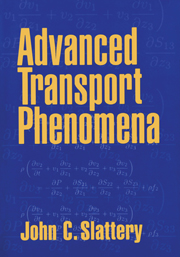Book contents
- Frontmatter
- Contents
- Preface
- List of Notation
- Advanced Transport Phenomena
- 1 Kinematics
- 2 Foundations for Momentum Transfer
- 3 Differential Balances in Momentum Transfer
- 4 Integral Averaging in Momentum Transfer
- 5 Foundations for Energy Transfer
- 6 Differential Balances in Energy Transfer
- 7 Integral Averaging in Energy Transfer
- 8 Foundations for Mass Transfer
- 9 Differential Balances in Mass Transfer
- 10 Integral Averaging in Mass Transfer
- A Tensor Analysis
- B More on the Transport Theorem
- References
- Author/Editor Index
- Index
2 - Foundations for Momentum Transfer
Published online by Cambridge University Press: 05 June 2012
- Frontmatter
- Contents
- Preface
- List of Notation
- Advanced Transport Phenomena
- 1 Kinematics
- 2 Foundations for Momentum Transfer
- 3 Differential Balances in Momentum Transfer
- 4 Integral Averaging in Momentum Transfer
- 5 Foundations for Energy Transfer
- 6 Differential Balances in Energy Transfer
- 7 Integral Averaging in Energy Transfer
- 8 Foundations for Mass Transfer
- 9 Differential Balances in Mass Transfer
- 10 Integral Averaging in Mass Transfer
- A Tensor Analysis
- B More on the Transport Theorem
- References
- Author/Editor Index
- Index
Summary
In what follows,the principal tools for studying fluid mechanics are developed. We begin by introducing the concept of force. Notice that force is not defined; it is a primitive concept in the same sense as is mass and the material particle in Chapter 1. This forms the basis for introducing our second and third postulates: the momentum balance and the moment of momentum balance. The stress tensor is introduced in order to derive the equations that describe at each point in a material the local balances for momentum and moment of momentum. The differential mass and momentum balances together with the symmetry of the stress tensor form the foundation for fluid mechanics.
We conclude our discussion with an outline of what must be said about real material behavior if we are to analyze any practical problems. It is especially at this point that statistical mechanics, based upon the molecular viewpoint of real materials, can be used to supplement the concepts developed in continuum mechanics. In continuum mechanics, we can indicate a number of rules that constitutive equations for the stress tensor must satisfy (the principle of determinism, the principle of local action, the principle of material frame indifference,…), but from first principles we cannot derive an explicit relationship between stress and deformation. If we work strictly within the bounds of continuum mechanics, we can derive such a relationship only by making some sort of assumption about its form.
- Type
- Chapter
- Information
- Advanced Transport Phenomena , pp. 28 - 64Publisher: Cambridge University PressPrint publication year: 1999



